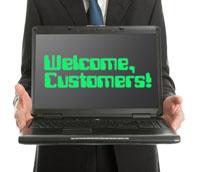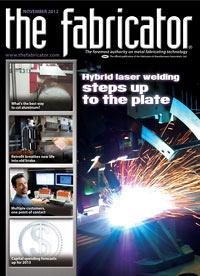Product Marketing Manager
- FMA
- The Fabricator
- FABTECH
- Canadian Metalworking
Categories
- Additive Manufacturing
- Aluminum Welding
- Arc Welding
- Assembly and Joining
- Automation and Robotics
- Bending and Forming
- Consumables
- Cutting and Weld Prep
- Electric Vehicles
- En Español
- Finishing
- Hydroforming
- Laser Cutting
- Laser Welding
- Machining
- Manufacturing Software
- Materials Handling
- Metals/Materials
- Oxyfuel Cutting
- Plasma Cutting
- Power Tools
- Punching and Other Holemaking
- Roll Forming
- Safety
- Sawing
- Shearing
- Shop Management
- Testing and Measuring
- Tube and Pipe Fabrication
- Tube and Pipe Production
- Waterjet Cutting
Industry Directory
Webcasts
Podcasts
FAB 40
Advertise
Subscribe
Account Login
Search
How a fabricator can stand out to customers
Driving preferred supplier status for your business
- By Christine Hansen
- November 9, 2012
- Article
- Shop Management

The best way for you to maintain or earn “preferred” status with your customers is to show them that they can have visibility into the your operations and tell them that they are always welcome to check on things, such as a job status or shipment delivery date.
Your customers have always demanded the best quality, lower prices, and streamlined delivery. But today your customers want something a little more … revealing. They want access to information about their parts, orders, shipments, product documentation, account status, and even deeper access to your business data, such as quality or job status.
Is your business prepared to address these new demands for information transparency? If your answer is not unequivocally “yes,” you are not alone. While you might view this new and emerging requirement as another hoop to jump through, there is another perspective: Providing this visibility can give your organization a competitive advantage—the ability to maintain your “preferred supplier” status with your customers.
Preparing for Openness
There are a number of considerations you should think about when architecting your operations to provide improved customer access.
Data on Tap. Before your business can provide open access to information, it first needs to ensure that the data made available to the customer is comprehensive and accurate. For many, this can be challenging, as they do not have or make good use of an embedded, end-to-end system that can naturally provide this data. Rather, these businesses are challenged to bring together information from separate systems, such as customer relationship management, sales, production, shipping, and finance, and then consolidate the data into a single view to present to the customer. This is a complicated and costly process.
If your organization has a fully embedded, end-to-end software system that has the capabilities to handle CRM, estimating, sales, production planning and scheduling, shop floor data collection, inventory, quality, shipping, and finance, you’re well-positioned to provide the necessary data framework to share with your customers.
The Portal Principle. Access to information is being driven to a self-serve model that enables business data analysts and power users to configure and present data as they desire. From a single query developed in the system, the software enables users to create an exception-based dashboard, where they can monitor the status of jobs, incoming purchases, and quality events. This dashboard then becomes available on a standard PC or mobile device, such as a tablet or smartphone.
This same query can be used to search the system. If a user enters a part number, every reference of the part in the system is displayed, including quotes, orders, jobs, quality events, and purchases. The same functionality can be used to generate a customer or supplier portal for sharing and collaborating on information. Whether your business is looking to share electronic documents, quality events, supplier blanket releases, sales orders, or shipment status updates, these portals can drive new efficiencies and give your business partners more access to what they need to ensure a smooth and streamlined supply chain.
The Saving Grace of Web Services. You should consider adopting technology built on a completely service-oriented architecture (SOA), where web services enable access to every function, from the first sales order to the final invoice. Systems built from the ground up on an SOA enable connectivity and access to business processes either through traditional interfaces for computing, such as a sales order form, through a mobile device, or through a string of data that is validated as it is connected and brought into the system. This means that receiving and sending electronic information and mapping to customers’ and suppliers’ systems are enabled at a fraction of what it cost in the past. In part this is due to the fact that tools already exist that can map data coming and going through the web services, making the effort to offer access a complex development task instead of a data-processing task. You can use these same tools to integrate nesting software into your production systems, streamlining production planning further.
Bypass Manual Processing. Finally, if you have ever been approached by a customer to electronically communicate through electronic data interchange (EDI), you understand the complexity and cost of accepting an 860 document (a purchase order change request) or an 856 document (advance shipping notice) into your system. Many businesses give up unless forced to and instead log in to their customer’s web portal to get their orders and order changes and then turn around and manually rekey the changes into their own enterprise resource planning (ERP) system.
These businesses lose out on the benefit of EDI with their customers. Reducing the unnecessary manual task of updating order changes is one benefit, but the real benefit is the speed at which your company can then respond to the latest changes in demand on the plant floor. Don’t be too shortsighted to recognize the opportunity to build in more operational responsiveness and agility.
Sealing the Deal With an Electronic Handshake
Your customers are dealing with marketplaces that increasingly demand service delivered the right away and their way. This need is in turn driving them to evaluate their supply chains—of which you are a part—and address their weakest links. Will your metal fabricating operation be identified as that weakest link, forcing your customers to seek other partners better equipped to meet these real-time information requirements?
There was a time when business was done with a handshake. Today this has been replaced with an electronic handshake. Your data systems must shake hands with your customers’ data systems.
As with any inflection point when it comes to embracing innovation, leaders and laggards will emerge. Manufacturers that standardize their business on the latest ERP technology have a competitive advantage through an end-to-end system that supports their manufacturing business processes, improves customer relationships, and fosters supply chain collaboration that leads to enhanced productivity and cost efficiencies. These leaders will master the show-and-tell game to maintain their preferred supplier status.
About the Author
Christine Hansen
4120 Dublin Blvd.
Dublin, CA 94568
925-361-9900
Related Companies
subscribe now

The Fabricator is North America's leading magazine for the metal forming and fabricating industry. The magazine delivers the news, technical articles, and case histories that enable fabricators to do their jobs more efficiently. The Fabricator has served the industry since 1970.
start your free subscription- Stay connected from anywhere

Easily access valuable industry resources now with full access to the digital edition of The Fabricator.

Easily access valuable industry resources now with full access to the digital edition of The Welder.

Easily access valuable industry resources now with full access to the digital edition of The Tube and Pipe Journal.
- Podcasting
- Podcast:
- The Fabricator Podcast
- Published:
- 04/16/2024
- Running Time:
- 63:29
In this episode of The Fabricator Podcast, Caleb Chamberlain, co-founder and CEO of OSH Cut, discusses his company’s...
- Trending Articles
AI, machine learning, and the future of metal fabrication

Employee ownership: The best way to ensure engagement

Steel industry reacts to Nucor’s new weekly published HRC price

Dynamic Metal blossoms with each passing year

Metal fabrication management: A guide for new supervisors

- Industry Events
16th Annual Safety Conference
- April 30 - May 1, 2024
- Elgin,
Pipe and Tube Conference
- May 21 - 22, 2024
- Omaha, NE
World-Class Roll Forming Workshop
- June 5 - 6, 2024
- Louisville, KY
Advanced Laser Application Workshop
- June 25 - 27, 2024
- Novi, MI


























